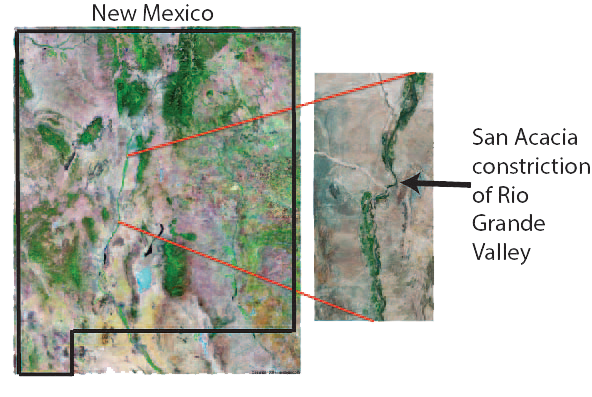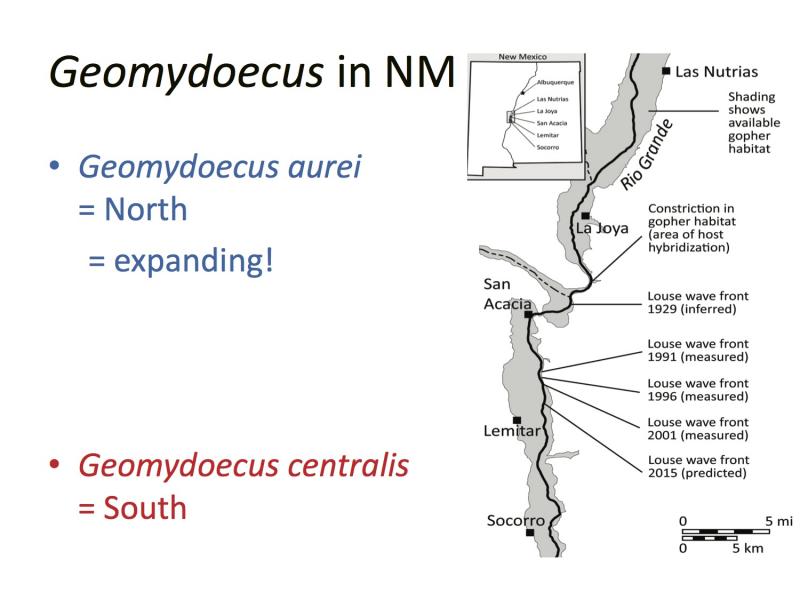The San Acacia Project At A Glance
What is so special about San Acacia, New Mexico?
About 95 kilometers (60 miles) south of Albuquerque and just north of the town of San Acacia, the Rio Grande passes from the wide Albuquerque basin to the north, through a narrow rocky canyon (4.5 million year old cooled lava known as basalt) into another wide basin, The Socorro Basin. This constriction of the otherwise wide and fertile Rio Grande valley is the narrowest throughout central New Mexico and is as little as 300 meters wide compared to over 3000 meters (2 miles) just north of the constriction at La Joya and far wider as the basin opens up further north. We call this the San Acacia Constriction because of the nearby town just south of the constriction.

Where the wider regions of the valley are typical (north and south of the constriction), fertile riparian wetland habitats, grasslands, and agriculture dominate the landscape. The rocky, narrow constriction is devoid of deep soils or abundant vegetation and provides little suitable habitat for a diverse group of animals.

A typical collection locality south of the constriction. Alfalfa field with signs of pocket gopher damage in foreground.
The gophers and lice.
At the narrow constriction, just north of San Acacia, two highly differentiated subspecies of pocket gophers (Thomomys bottae connectens and T. b. opulentus) come into contact and hybridize (Smith et al., 1983; http://hdl.handle.net/1928/24430). Genetic differences between pocket gophers on opposite sides of the constriction are similar to those between some full species of mammals. There are also chromosomal differences. These two subspecies of pocket gophers host two different species of lice in the genus Geomydoecus. Geomydoecus centralis is found only on the southern pocket gopher and G. aurei is found on the northern pocket gopher and has also crossed through the constriction and is colonizing pocket gophers to the south (Demastes et al, 1998; Hafner et al., 1998). Prior to flood control, the Rio Grande was subject to seasonal flooding that would have inundated the constriction. The last major flood of the region occurred in 1929. Shortly thereafter, G. aurei colonized the southern pocket gophers and has been expanding its range southward at an average rate of about 100 meters a year. We have been tracking this movement and have genetic samples from 1991, 1996, 2001, and 2016. We are using these genetic samples to study the effects of range shifts on the population genetics or organisms. Most models predict a loss of genetic diversity in the populations on the leading front of the expansion. We will be able to test these predictions and others such as how do populations recover from this reduction. For example, populations that were on the front lines in 1991 for which we have samples, have now had nearly 270 louse-generations to recover. We can compare diversity estimates from these same populations sampled in 1991 and 2016.

Demastes, J. W., M. S. Hafner, D. J. Hafner, and T. A. Spradling. 1998 Pocket gophers and their chewing lice: a test of the maternal transmission hypothesis. Molecular Ecology, 7:1065-9.
Hafner, M. S., J. W. Demastes, D. J. Hafner, T. A. Spradling, P. D. Sudman and S. A. Nadler.1998 Age and movement of a hybrid zone: Implications for dispersal distance in pocket gophers and their chewing lice. Evolution, 52:278-282.
